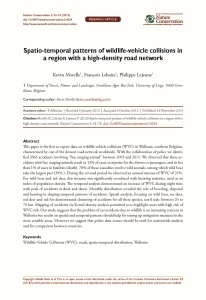Morelle K., Lehaire F., Lejeune P.
This paper is the first to report data on wildlife-vehicle collisions (WVC) in Wallonia, southern Belgium, characterised by one of the densest road network worldwide. With the collaboration of police we identified 3965 accidents involving “free ranging animal” between 2003 and 2011. We observed that these accidents with free ranging animals result in 13% of cases in injuries for the drivers or passengers, and in less than 1% of cases in fatalities (death). 78% of these casualties involve wild animals, among which wild boar take the largest part (39% ). During the covered period we observed an annual increase of WVC of 21%. For wild boar and red deer, this increase was significantly correlated with hunting statistics, used as an index of population density. The temporal analysis demonstrated an increase of WVC during night time with peak of accidents at dusk and dawn. Monthly distribution revealed the role of breeding, dispersal and hunting in shaping temporal patterns of accidents. Spatial analysis, focusing on wild boar, roe deer, red deer and red fox demonstrated clustering of accidents for all these species, until scale between 20 to 70 km. Mapping of accidents via Kernel density analysis permitted us to highlight areas with high risk of WVC risk. Our study suggests that the problem of car accidents due to wildlife is an increasing concern in Wallonia but results on spatial and temporal patterns should help for setting up mitigation measures in the most sensible areas. Moreover we suggest that police data source should be used for nationwide analysis and for comparison between countries.
Consultez la fiche complète de l’article sur ORBi

